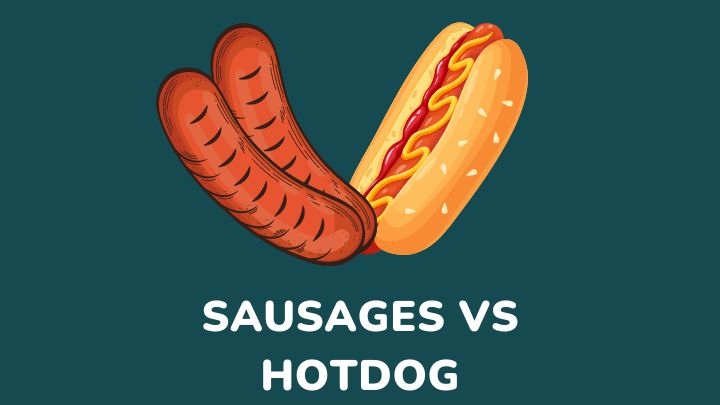Sausages and hotdogs are two widely beloved staples, each with its unique charm and flavor. But do you know the real differences between them? To help you out, here’s a detailed comparison of sausage vs hotdog.
Ahead, you will learn their rich history, their major differences, and why understanding their distinctions is key to elevating your culinary experience.
Would you like to discover the traditional methods for both sausages and hotdogs, creative serving ideas as well as tips to help you make healthier choices?
Keep reading to learn all that and more.
What is sausage?
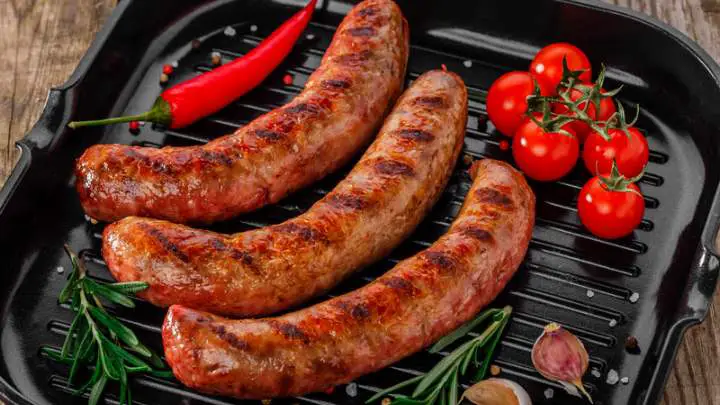
Sausage is a timeless treat that’s pleased palates for ages, transcending borders and cultures. But what exactly makes it so special?
Sausage is a blend of finely ground meat, carefully spiced with herbs and seasonings, then wrapped in a tasty casing. Its story begins in ancient times when clever cooks invented sausages to preserve and enjoy their meats.
From Italian sausages like spicy pepperoni to German bratwurst, there’s a wide range to explore. Don’t forget about chorizo from Spain, with its bold and smoky flavors, or the garlicky goodness of Polish kielbasa.
Each variety reflects its own culture and taste. Whether grilling or simmering, sausages offer a delicious glance into history and tradition, with each bite telling a flavorful tale.
What is a hotdog?
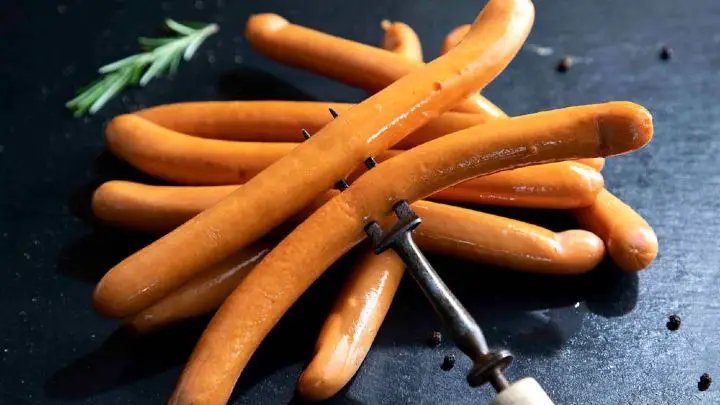
A hotdog is a type of sausage made from finely ground meat, typically pork, beef, or a blend, encased in a smooth, edible casing.
Its origins can be traced back to European and American culinary traditions, where it emerged as a convenient and portable snack.
Today, hotdogs come in various forms, from classic franks to gourmet creations. Whether it’s the all-American beef hotdog, the spicy kick of a chili dog, or the smoky flavor of a bratwurst, there’s a hotdog to suit every taste and occasion.
Sausage vs hotdog: Ingredients
Sausages typically feature a hearty mix of ground meat, such as beef, pork, chicken, or a combination, providing a rich source of protein.
To enhance flavor, they’re seasoned with a variety of herbs and spices, like garlic, paprika, and fennel seeds.
While some traditional recipes stick to natural ingredients, others may contain additives like salt, sugar, and curing agents for preservation.
Hotdogs, on the other hand, often blend finely ground meats, such as beef, pork, or chicken, with fillers like breadcrumbs or starches to achieve a uniform texture.
They’re seasoned with a simpler mix of spices and flavorings, aiming for a consistent taste. However, hotdogs may also contain additives, fillers, and preservatives to extend shelf life and maintain flavor.
The main distinction lies in the meat content and processing. Sausages tend to have a higher meat content, offering a more robust flavor and richer nutritional profile.
In contrast, hotdogs may contain a lower percentage of meat, coupled with fillers and additives to achieve a uniform texture and taste.
This difference can impact health, as higher meat content provides more protein and essential nutrients, while additives and fillers may contribute to higher sodium and fat content.
Sausage vs hotdog: Meat content
In terms of meat content, sausages typically boast a higher percentage of beef, pork, or chicken compared to hotdogs. This translates to a more intense meat flavor and denser texture in sausages, making them a favorite among meat lovers.
Hotdogs, meanwhile, may contain a blend of meats and fillers, resulting in a smoother texture and milder taste.
Opting for minimally processed varieties and reading labels carefully can help make healthier choices when enjoying sausages or hotdogs.
Sausage vs hotdog: Nutritional profile
According to the US Department of Agriculture, a 100-gram serving of sausage contains:
- Calories: 301
- Total fat: 27 g
- Saturated fat: 9g
- Cholesterol: 71 mg
- Sodium 848 mg
- Potassium 189 mg
- Total carbohydrate 2 g
- Protein 12 g
It also includes small amounts of iron, vitamin D, vitamin B6, cobalamin, and magnesium
According to the US Department of Agriculture, a 100 grams serving of hotdog contains:
- Calories: 290
- Total Fat: 26 g
- Saturated Fat: 8 g
- Total Carbohydrate: 4.2 g
- Protein: 10 g
- Cholesterol: 77 mg
- Sodium 1,090 mg
- Potassium 152 mg
It also contains small amounts of calcium, iron, vitamin B6, cobalamin, magnesium
Sausage vs hotdog: Flavor profile
Varieties of flavors in sausages
Sausages boast a kaleidoscope of flavors, thanks to a diverse array of ingredients and seasonings.
From the zesty tang of Italian sausage seasoned with garlic and fennel to the smoky richness of Polish kielbasa infused with paprika and marjoram, there’s a sausage to suit every palate.
The use of spices, herbs, and even regional specialties like cheese or wine contribute to the unique flavor profiles that distinguish each variety.
Flavor profiles of different types of hotdogs
Hotdogs, while simpler in composition, still offer a range of taste experiences. Classic hotdogs feature a well-balanced blend of savory and slightly salty flavors, accented by hints of garlic and onion.
Gourmet hotdogs may take on bolder profiles, incorporating ingredients like jalapeños, bacon, or even truffle oil for a more indulgent experience.
Sausage vs hotdog: Taste
Several factors influence the taste of sausages and hotdogs, including the quality of ingredients, the blending of spices, and the cooking method.
The type of meat used, the ratio of fat to lean, and the level of seasoning all play a role in shaping the final flavor profile.
Additionally, smoking methods, such as using wood chips or charcoal, can impact distinct smoky notes that elevate the overall taste experience.
Sausage vs hotdog: Processing methods
Making sausages
Sausage-making begins with selecting high-quality cuts of meat, which are then trimmed of excess fat and diced into smaller pieces.
The meat is seasoned with a blend of herbs, spices, and flavorings, customized to suit the desired flavor profile. Next, the seasoned meat is mixed thoroughly to ensure an even distribution of flavors.
Once mixed, the meat is stuffed into casings—either natural or synthetic—using a sausage stuffer or grinder attachment.
Finally, the sausages are formed into links or left as bulk sausage before being cooked, smoked, or cured, depending on the recipe.
Making hotdogs
Hotdog production typically starts with finely grinding meats, often a blend of beef, pork, or chicken, along with other ingredients like fillers, flavorings, and preservatives.
The ground meat mixture is emulsified to achieve a smooth, uniform texture, and then seasoned with spices and flavor enhancers.
The seasoned mixture is piped into casings or molded into shape, before undergoing cooking and smoking processes to enhance flavor and ensure food safety.
Once cooked, hotdogs are cooled, packaged, and often pasteurized to extend shelf life.
Variations in preparation techniques
While both sausages and hotdogs share common steps in their preparation, variations in techniques and ingredients result in distinct culinary experiences.
Sausages may be fresh, smoked, or cured, with regional variations in seasoning and casing choices. Hotdogs, on the other hand, are typically cooked and smoked before packaging, with options for skin-on or skinless varieties.
Additionally, gourmet hotdogs may undergo specialized cooking methods, such as grilling or charbroiling, to enhance flavor and texture.
Impact of processing methods
The processing methods employed in sausage and hotdog production can significantly influence their health and taste.
While traditional methods prioritize natural ingredients and minimal processing, commercial varieties may contain additives, fillers, and preservatives to enhance shelf life and uniformity.
Cooking methods like grilling or baking can further enhance the flavor and nutritional profile of sausages and hotdogs, making them a delicious and satisfying addition to any meal.
Serving suggestions
Serving ideas for sausages
1. Grilled to perfection

Fire up the grill and cook sausages until they’re beautifully charred on the outside and juicy on the inside. Serve them on a platter for easy sharing.
2. On a bun

Place grilled sausages in a soft bun and top them with classic condiments like mustard and ketchup for a simple and satisfying meal.
3. Sausage skewers

Thread grilled sausages onto skewers along with colorful veggies like bell peppers and onions for a fun and flavorful presentation.
4. Stuffed peppers

Hollow out bell peppers and stuff them with cooked sausage, rice, and cheese for a hearty and satisfying meal.
Serving ideas for hotdogs
1. Classic BBQ

Whether at a backyard barbecue or a sports event, hotdogs are a staple. Serve them hot off the grill with a side of potato salad and baked beans for a quintessential American feast.
2. Street food style

Embrace the spirit of street food by serving hotdogs from a food cart or stand. Offer a variety of toppings and sauces for guests to customize their hotdogs to their liking.
3. Hotdog sliders
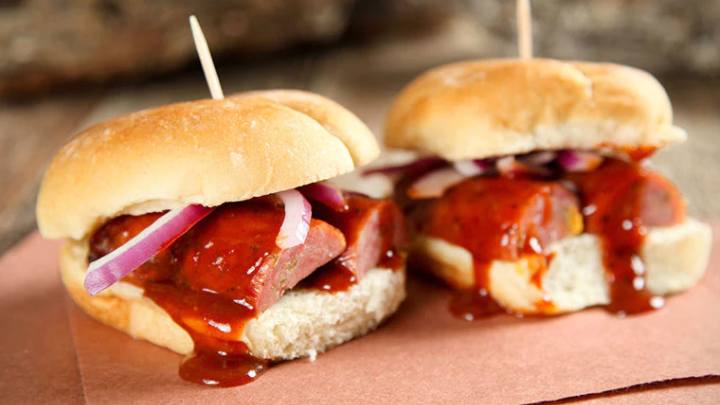
Cut hotdog buns into smaller pieces and fill them with mini hotdogs and a variety of toppings for bite-sized snacks that are perfect for parties.
4. Hotdog tacos

Swap out traditional taco shells for grilled hotdog buns and fill them with taco-seasoned ground beef, shredded cheese, and salsa for a tasty twist on taco night.
Accompaniments and condiments
Mustard

Tangy and versatile, mustard adds a flavorful kick to sausages and hotdogs. Choose from classic yellow mustard, spicy Dijon, or whole-grain varieties.
Ketchup

Sweet and savory, ketchup is a beloved condiment for hotdogs, providing a burst of tomato flavor that complements the salty richness of the meat.
Relish

Made from pickled cucumbers, relish adds a crunchy texture and tangy flavor to sausages and hotdogs. Choose from sweet or dill relish for a delicious contrast of flavors.
Sauerkraut

Tangy and fermented, sauerkraut is a classic accompaniment to sausages, offering a refreshing crunch and a hint of acidity that cuts through the richness of the meat.
Onions

Whether caramelized, grilled, or raw, onions add depth and sweetness to sausages and hotdogs. Try red onions for a pop of color and flavor.
Cheese

Melted cheese adds a creamy richness to sausages and hotdogs. Choose from cheddar, Swiss, or pepper jack for a deliciously gooey topping that takes your meal to the next level.
Pickles
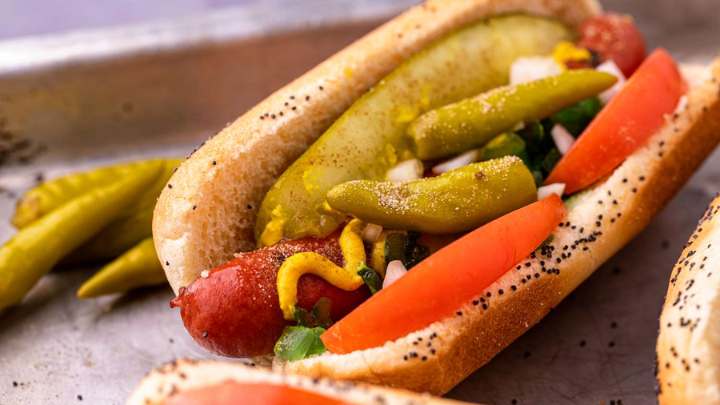
Crunchy and tangy, pickles are a refreshing addition to sausages and hotdogs, providing a burst of acidity that balances out the savory flavors of the meat.
Health consideration
Health benefits and risks of sausages
Sausages can be a good source of protein and essential nutrients like iron and B vitamins, especially if made from lean meats.
However, they are often high in saturated fat and sodium, which can increase the risk of heart disease and high blood pressure when consumed in excess.
Additionally, processed sausages may contain additives and preservatives, which have been linked to certain health concerns.
Health benefits and risks of hotdogs
Similarly, hotdogs provide a convenient source of protein, but they also tend to be high in sodium and saturated fat, especially in commercially processed varieties.
Regular consumption of hotdogs has been associated with an increased risk of certain health conditions, including cardiovascular disease and colorectal cancer.
Additionally, the use of nitrites and nitrates as preservatives in hotdogs has raised concerns about their potential health effects.
Tips for making healthier choices
Choose leaner varieties
Opt for sausages and hotdogs made from lean meats like chicken or turkey, or look for low-fat options to reduce saturated fat intake.
Read labels
Check the ingredient list and nutrition facts label to identify additives, preservatives, and sodium content. Choose products with minimal processing and fewer additives.
Limit portion sizes
Enjoy sausages and hotdogs in moderation and be mindful of portion sizes to avoid excessive intake of unhealthy fats and sodium.
Incorporate veggies
Pair sausages and hotdogs with plenty of vegetables to add fiber, vitamins, and minerals to your meal. Try topping hotdogs with sautéed onions and peppers or serving sausages alongside a colorful salad.
Opt for healthier cooking methods
Grill, bake, or broil sausages and hotdogs instead of frying to reduce added fats. This helps retain flavor without compromising on taste or texture.
FAQs
Which is healthier, sausages or hotdogs?
It depends on factors like meat content, processing, and portion size. Generally, opting for leaner meats and minimal processing can make both healthier options.
Can sausages and hotdogs be part of a healthy diet?
Yes, when consumed in moderation and paired with nutritious accompaniments like vegetables, sausages and hotdogs can fit into a balanced eating plan.
How should sausages and hotdogs be cooked to maximize flavor and minimize health risks?
Grilling, baking, or broiling are healthier cooking methods that retain flavor without adding excessive fats. It’s also important to avoid charring, which can create potentially harmful compounds.
Can sausages and hotdogs be enjoyed by people with dietary restrictions?
Yes, there are many plant-based and vegetarian alternatives available for those with dietary restrictions or preferences. These options offer similar textures and flavors without the use of animal products.
Conclusion
It’s clear no news that both sausages and hotdogs hold a special place in the hearts—and stomachs—of food enthusiasts everywhere.
When it comes to choosing between sausages and hotdogs, factors like personal taste preferences, dietary considerations, and cooking methods play a significant role.
Those seeking a richer, more diverse flavor experience may lean towards sausages, while those craving convenience and simplicity may opt for hotdogs.
As you enjoy any of these beloved staples, remember to eat in moderation and combine with healthy accompaniments to have a balanced diet.
Additionally, find out the differences between these two similar sausages – andouille and kielbasa sausages.
Thanks for reading.
